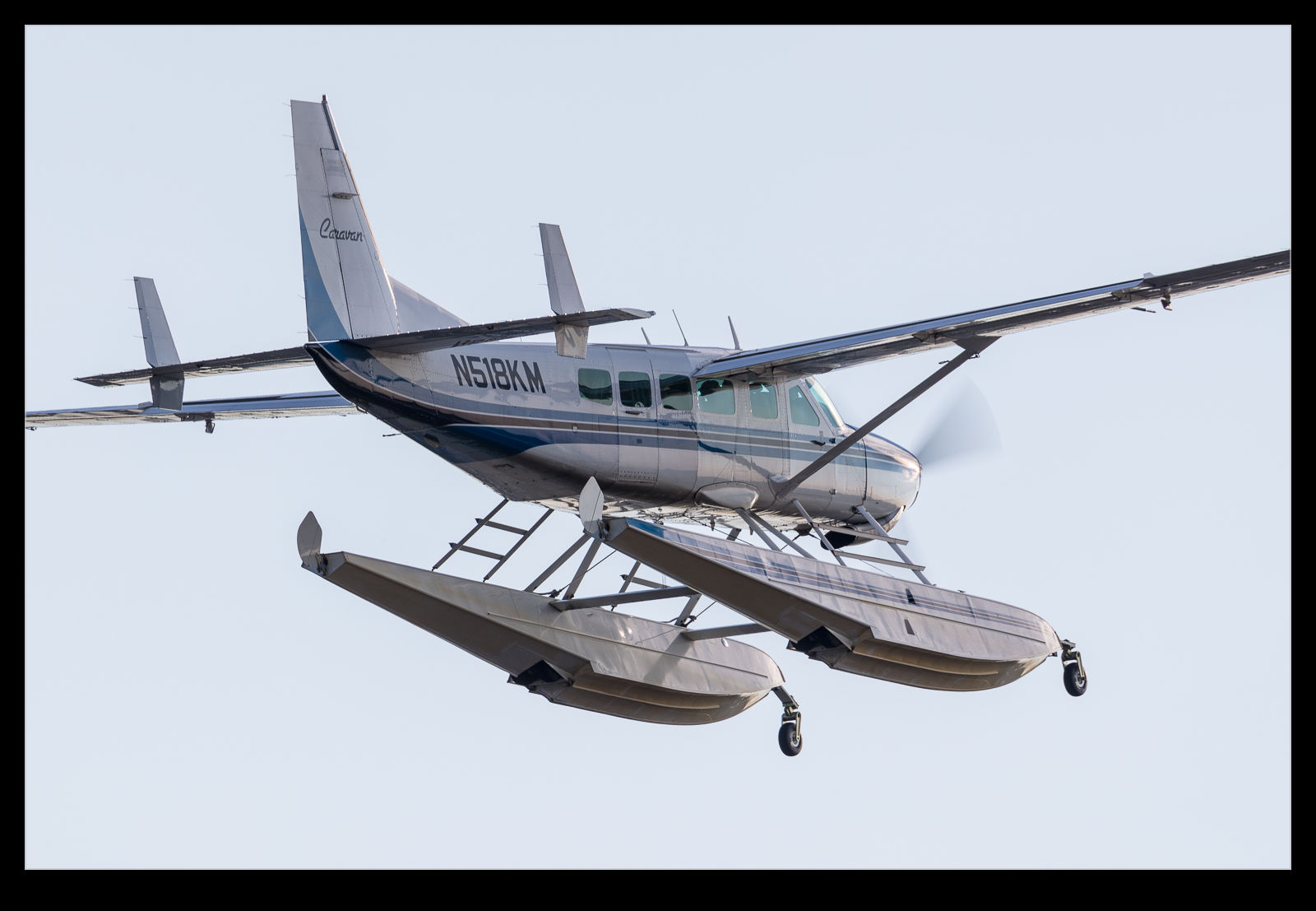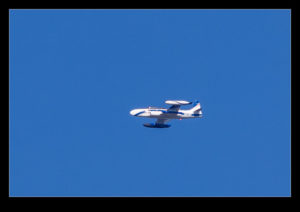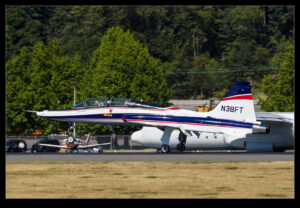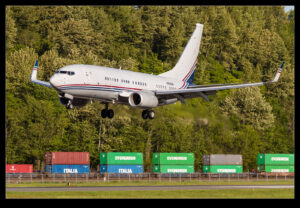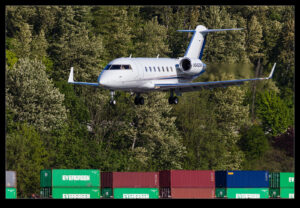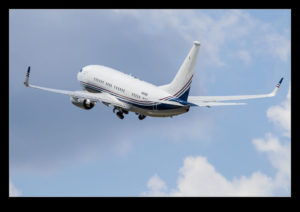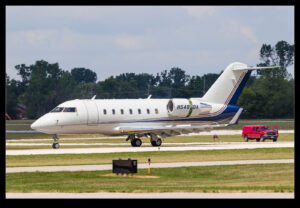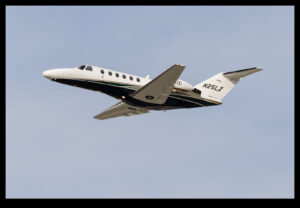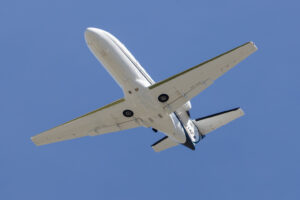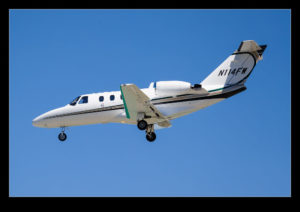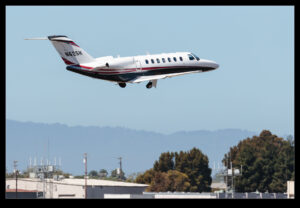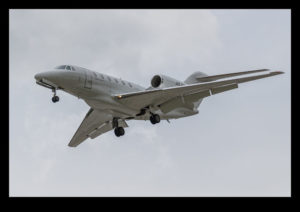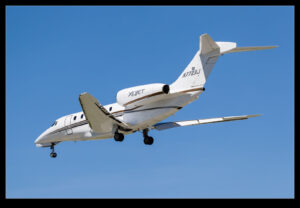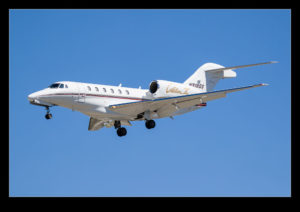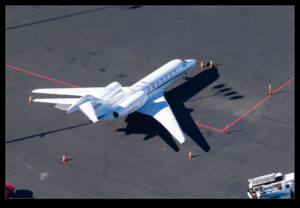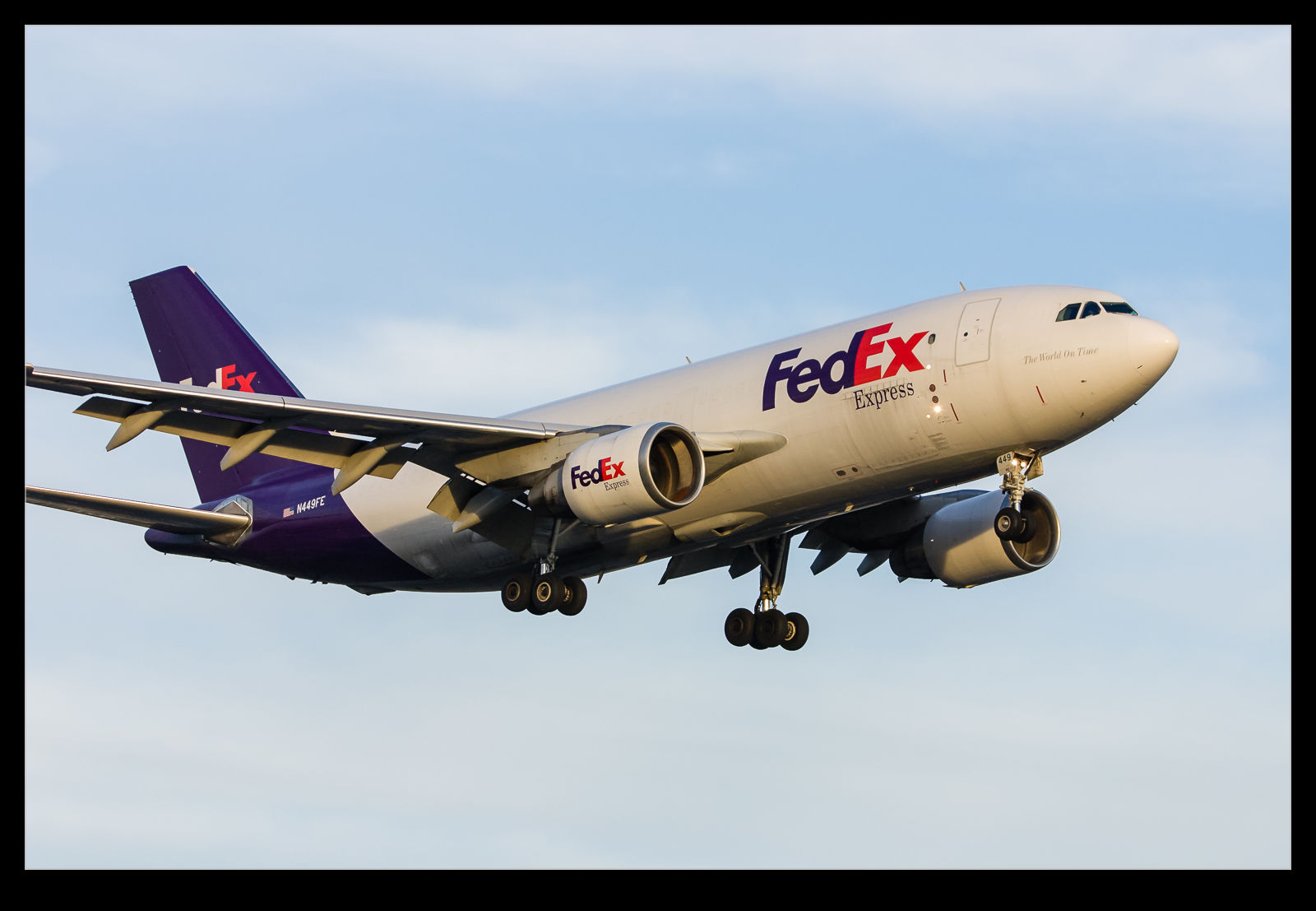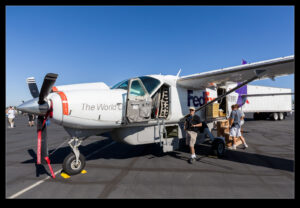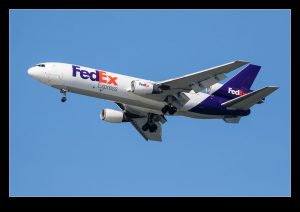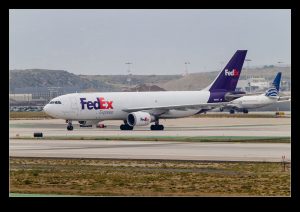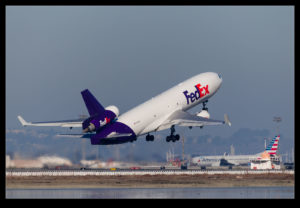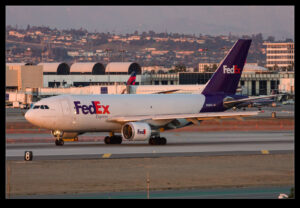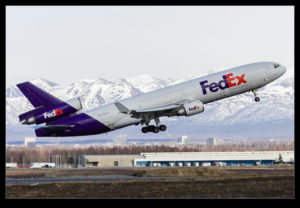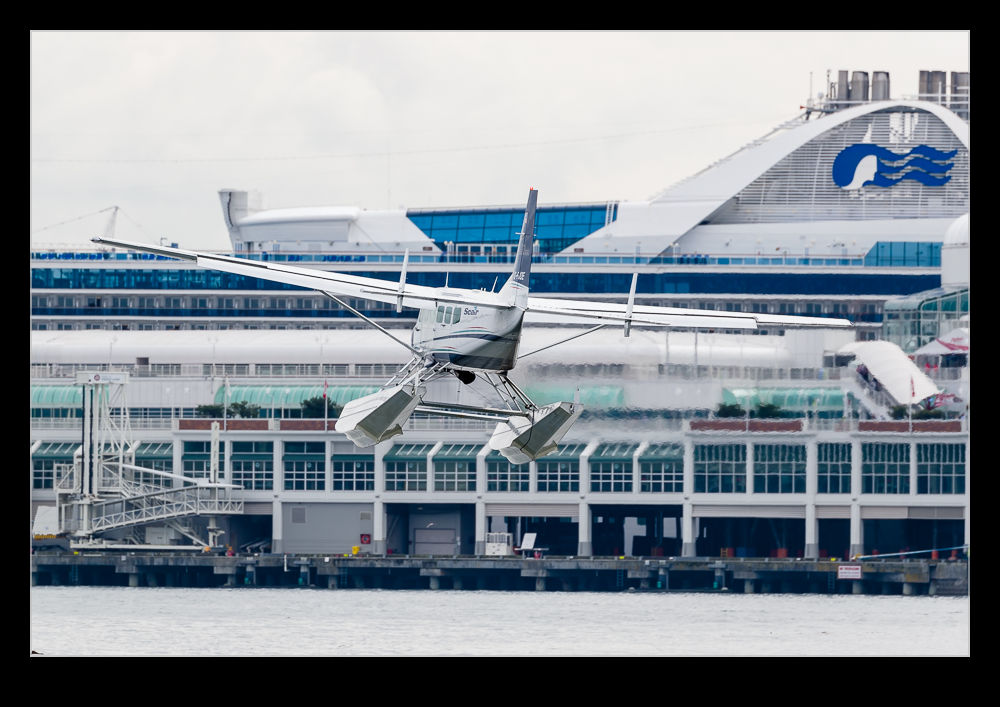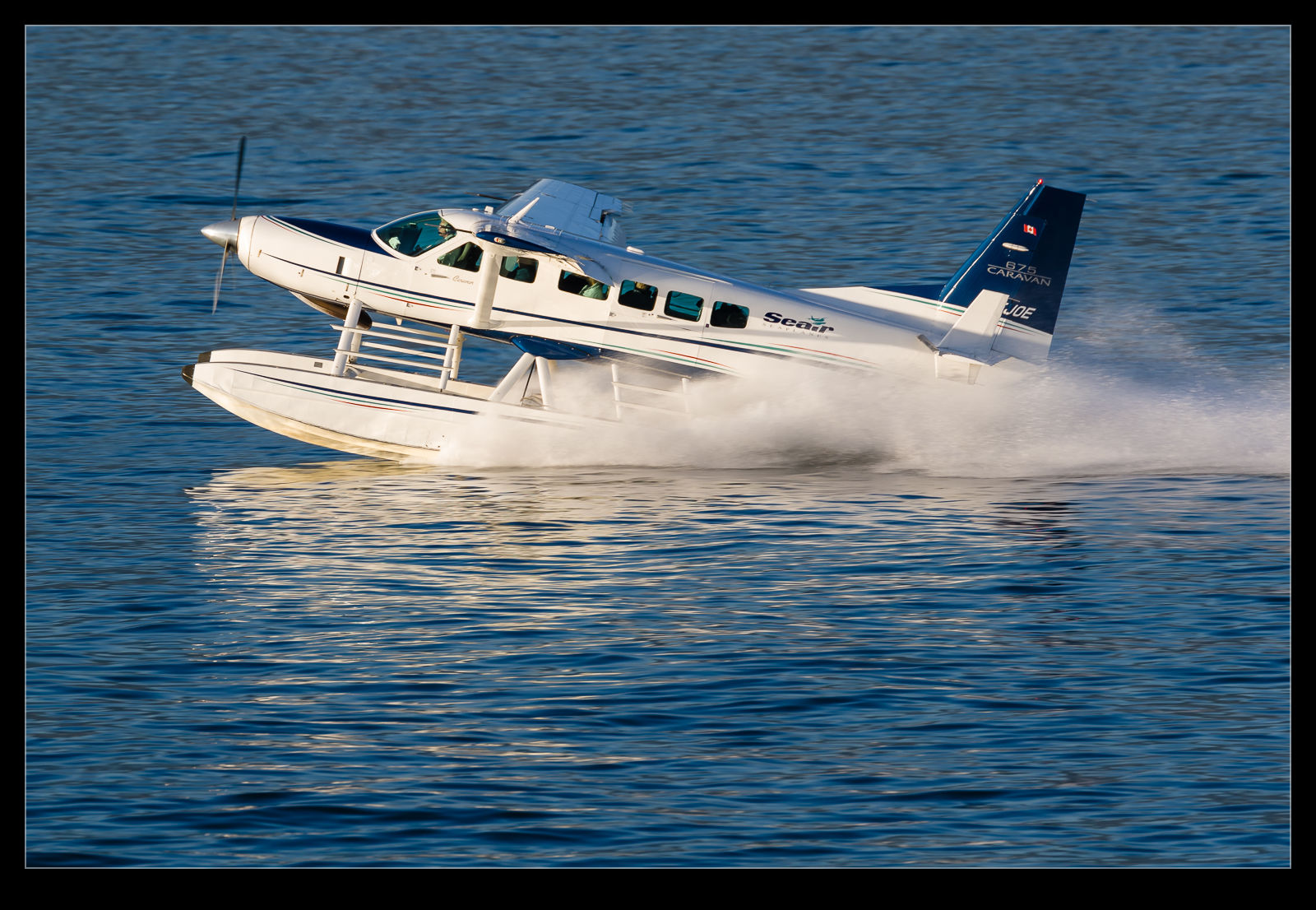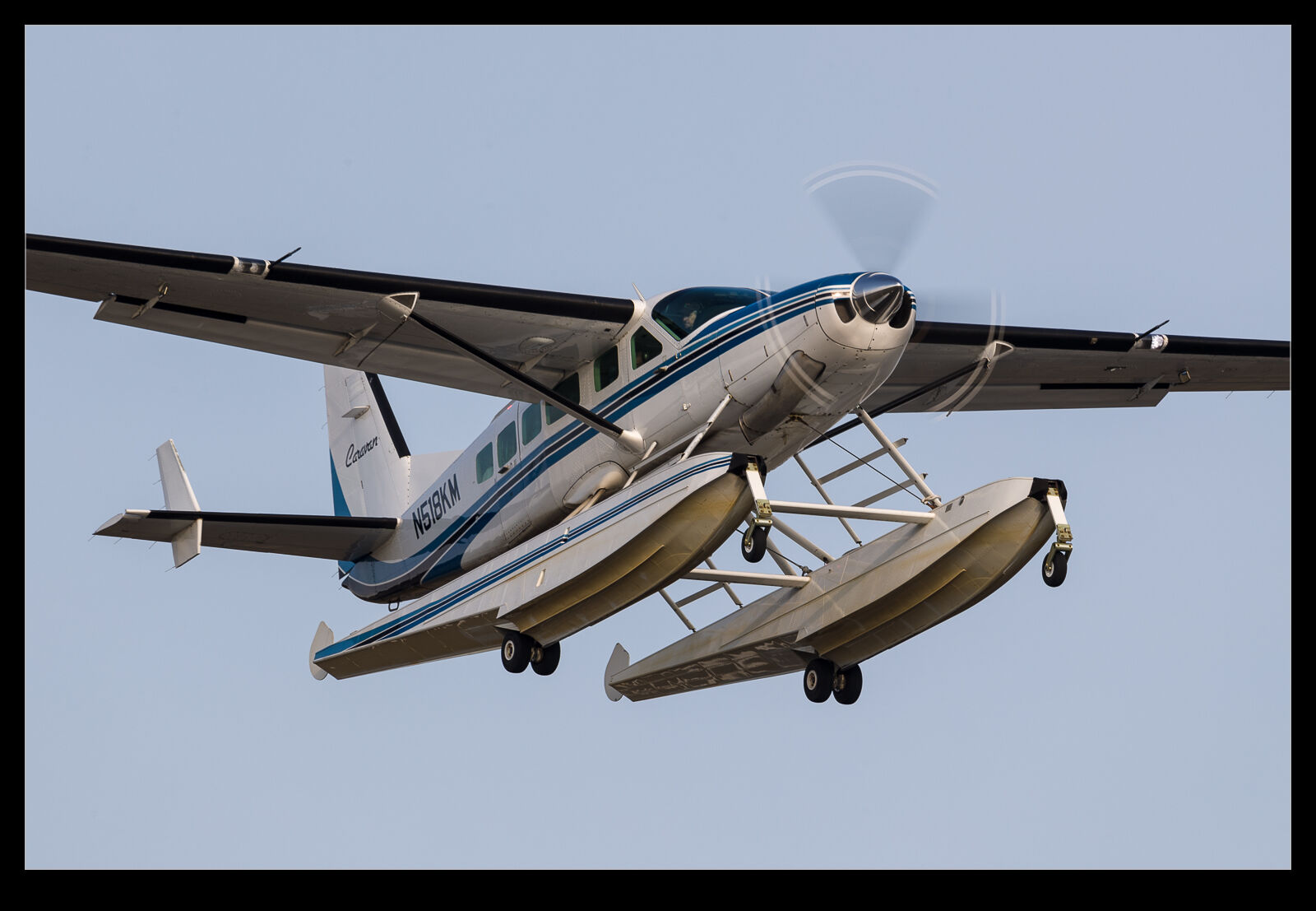 When I watched a Cessna Caravan on floats landing in Vancouver Harbour, I was rather critical of its water handling characteristics. It wallowed horribly and didn’t look like it was supposed to be there at all. However, the Caravan is not a bad plane and it is quite a rugged workhorse so I don’t have a gripe with it per se. Another float equipped example took off from Paine Field while I was awaiting something else and the combination of the afternoon light and the closeness to the plane meant I was rather pleased with the shots that were possible.
When I watched a Cessna Caravan on floats landing in Vancouver Harbour, I was rather critical of its water handling characteristics. It wallowed horribly and didn’t look like it was supposed to be there at all. However, the Caravan is not a bad plane and it is quite a rugged workhorse so I don’t have a gripe with it per se. Another float equipped example took off from Paine Field while I was awaiting something else and the combination of the afternoon light and the closeness to the plane meant I was rather pleased with the shots that were possible.
Tag Archives: cessna
Boeing’s Fleet of Runabouts
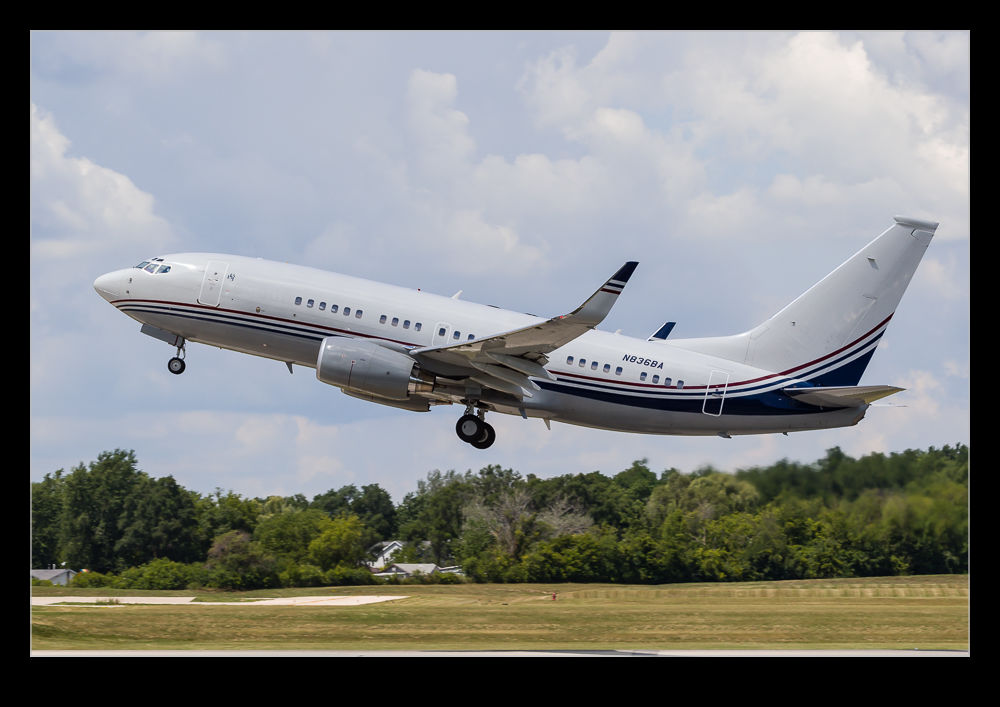 While the big jets are what Boeing is known for, they have a number of other aircraft that they use for their own purposes. I haven’t got all of these by any stretch of the imagination but I have come across a few at various times. They have BBJs that they use for executive transport. They also have some Bombardier Challengers that are able to promptly get people from A to B.
While the big jets are what Boeing is known for, they have a number of other aircraft that they use for their own purposes. I haven’t got all of these by any stretch of the imagination but I have come across a few at various times. They have BBJs that they use for executive transport. They also have some Bombardier Challengers that are able to promptly get people from A to B.
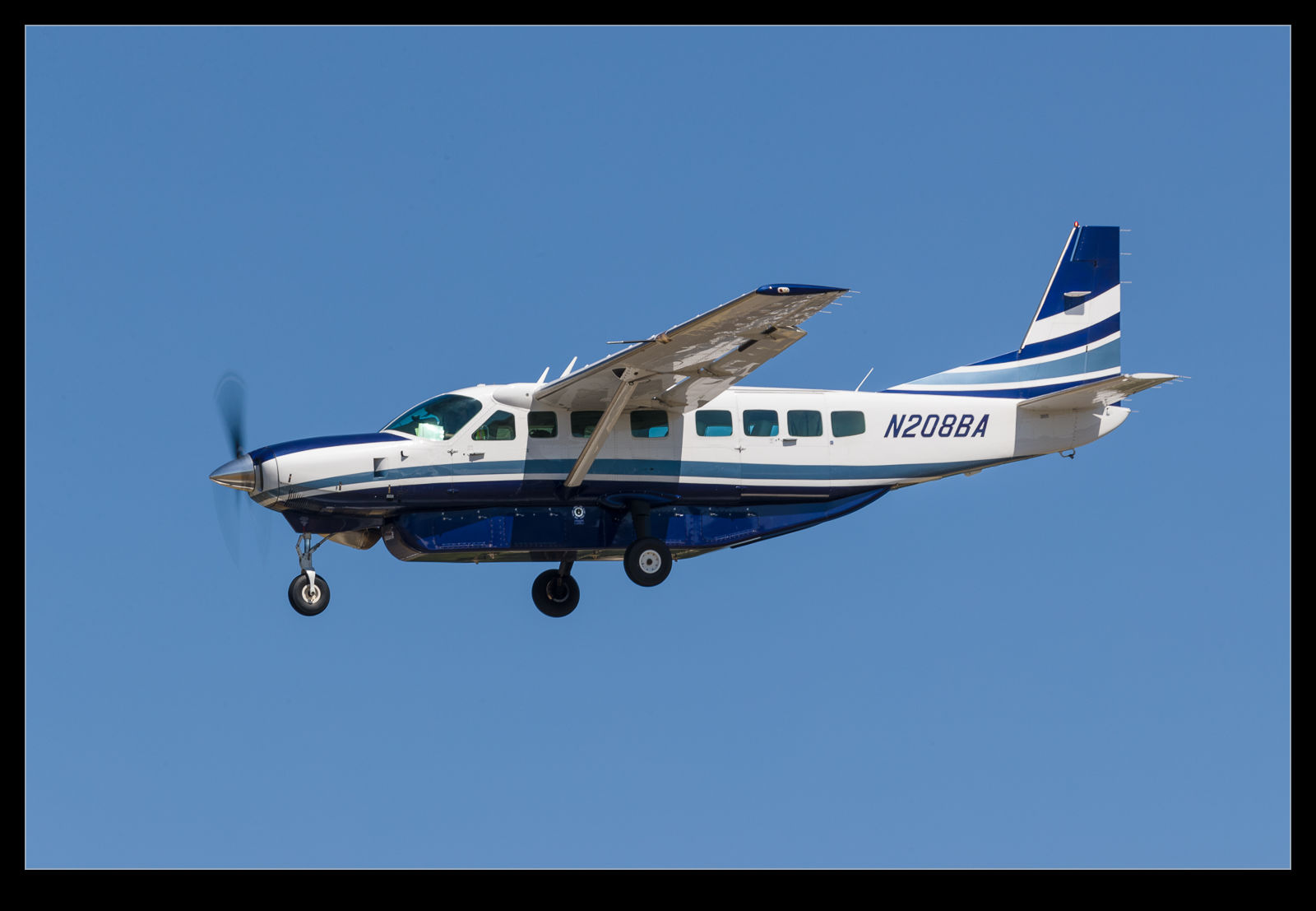 If you are looking a bit more locally, there is at least one Cessna Caravan that is used for various duties. I am not sure what its role is exactly but I imagine it is a handy way of getting people around the northwest and it can probably also move parts up to a certain size if needed.
If you are looking a bit more locally, there is at least one Cessna Caravan that is used for various duties. I am not sure what its role is exactly but I imagine it is a handy way of getting people around the northwest and it can probably also move parts up to a certain size if needed.
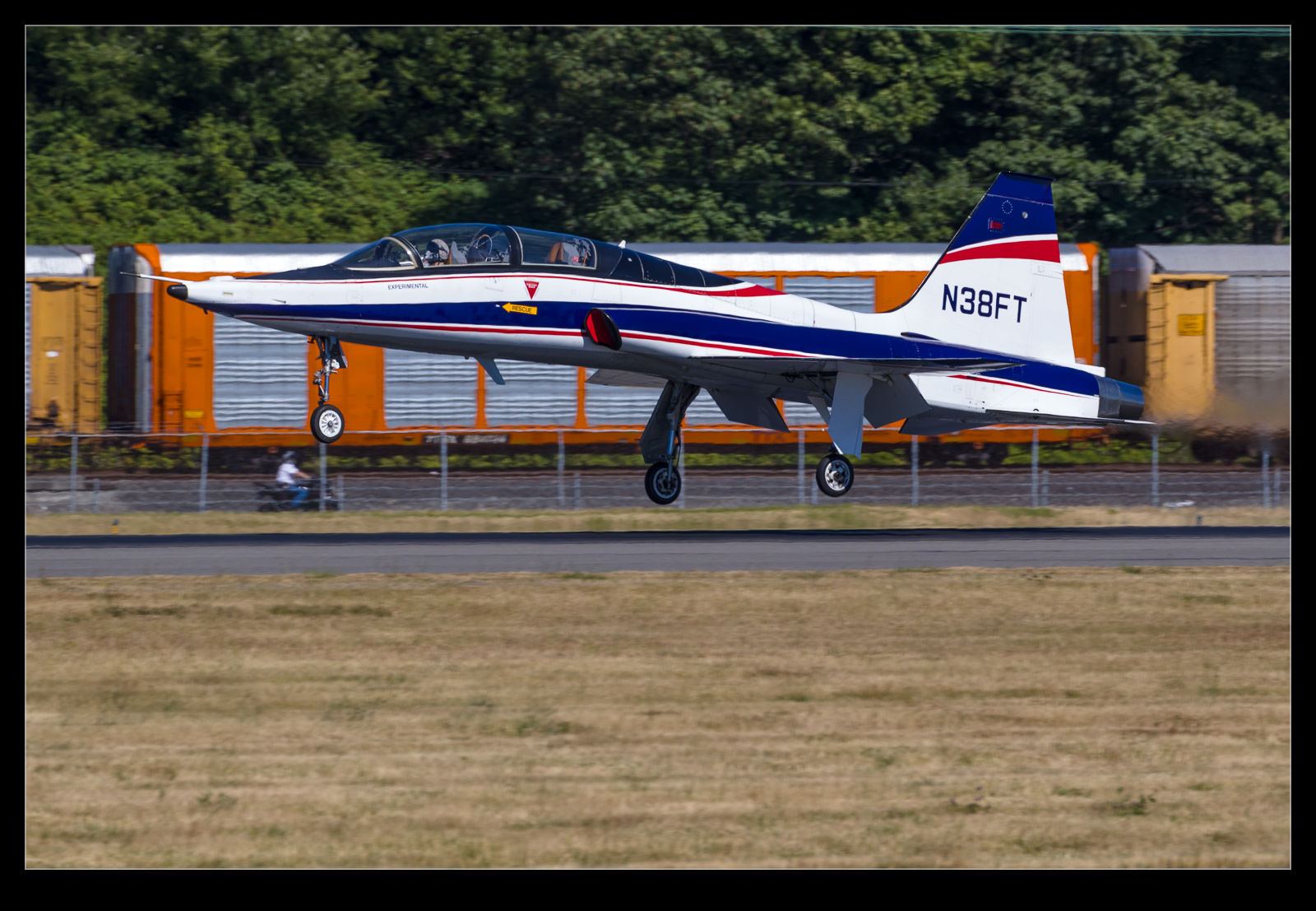 Another runabout is a Northrop T-38. This can be used for chase duties but I also suspect it is a crew hack since it seems to make regular runs between BFI and Moses Lake without crossing paths with any of the test aircraft. There are also T-33s used for chase work but, sadly, I have get close to any in action. Just a distant overflight shot. Hopefully I will see them before too long.
Another runabout is a Northrop T-38. This can be used for chase duties but I also suspect it is a crew hack since it seems to make regular runs between BFI and Moses Lake without crossing paths with any of the test aircraft. There are also T-33s used for chase work but, sadly, I have get close to any in action. Just a distant overflight shot. Hopefully I will see them before too long.
BA 747 Formation with a Cessna?
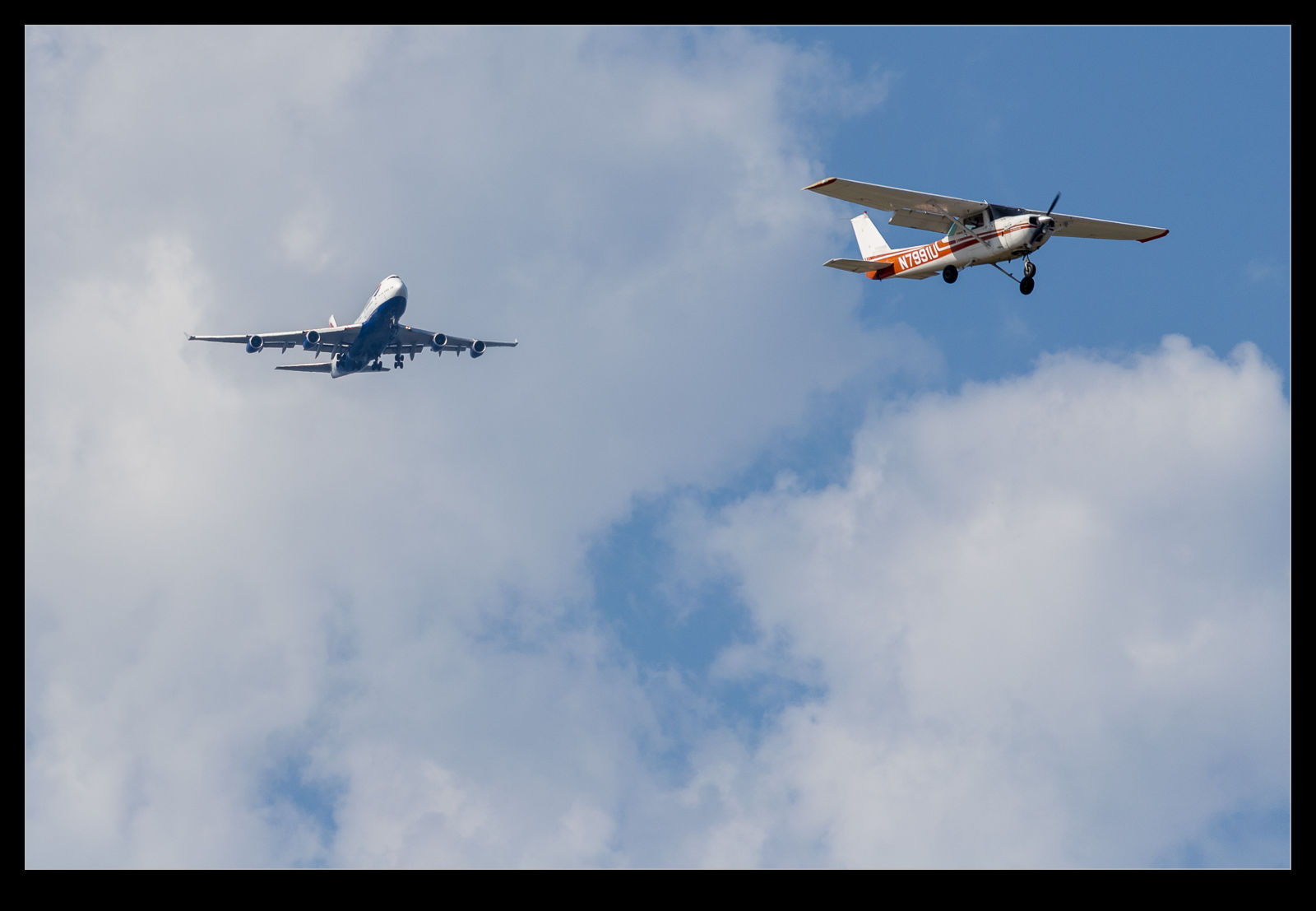 The path of jets into SeaTac from the north takes them right over Boeing Field. Sometimes, when you are watching something on one path, something going into the other field gets in your field of view. Either that or a British Airways Boeing 747-400 decided to sneak up on a Cessna. Knowing some guys who fly for them, I wouldn’t rule it out.
The path of jets into SeaTac from the north takes them right over Boeing Field. Sometimes, when you are watching something on one path, something going into the other field gets in your field of view. Either that or a British Airways Boeing 747-400 decided to sneak up on a Cessna. Knowing some guys who fly for them, I wouldn’t rule it out.
Lots of Cessna’s Small Jets
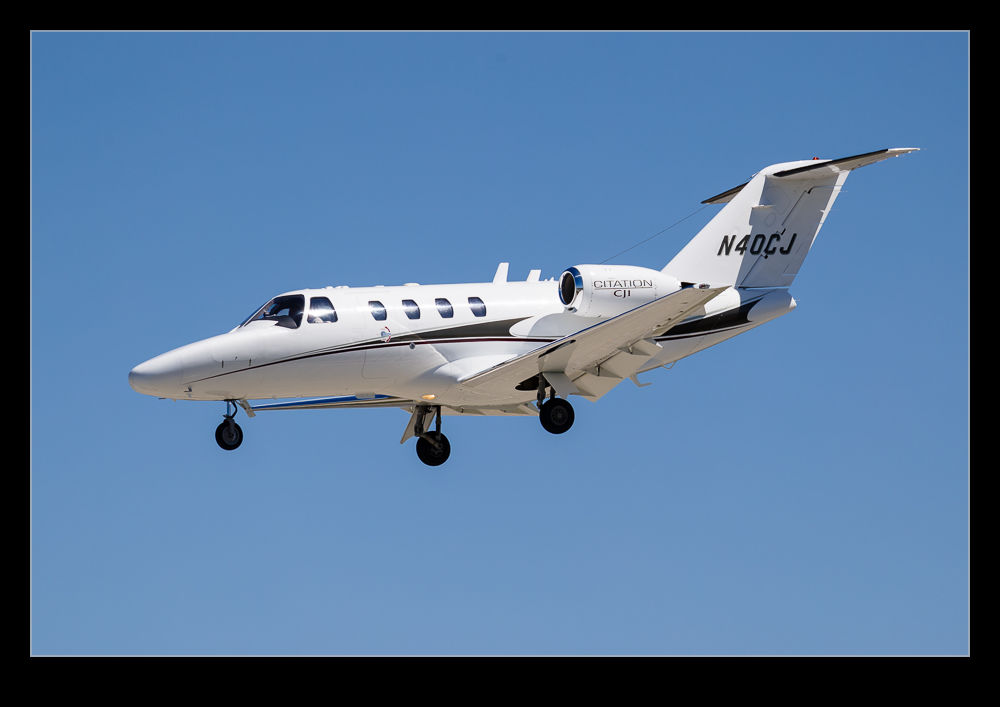 I like bizjets but, if I am honest, my preference is for the bigger jets. The small jets are probably a more useful business tool but the big ones just look cooler. I recently have come across a steady stream of the smaller products though. The majority of these have been from the Cessna stable with CJs of various sizes popping up in front of me. Normally I don’t give them too much attention but today I am going to share a selection of the little fellas.
I like bizjets but, if I am honest, my preference is for the bigger jets. The small jets are probably a more useful business tool but the big ones just look cooler. I recently have come across a steady stream of the smaller products though. The majority of these have been from the Cessna stable with CJs of various sizes popping up in front of me. Normally I don’t give them too much attention but today I am going to share a selection of the little fellas.
Citation Xs
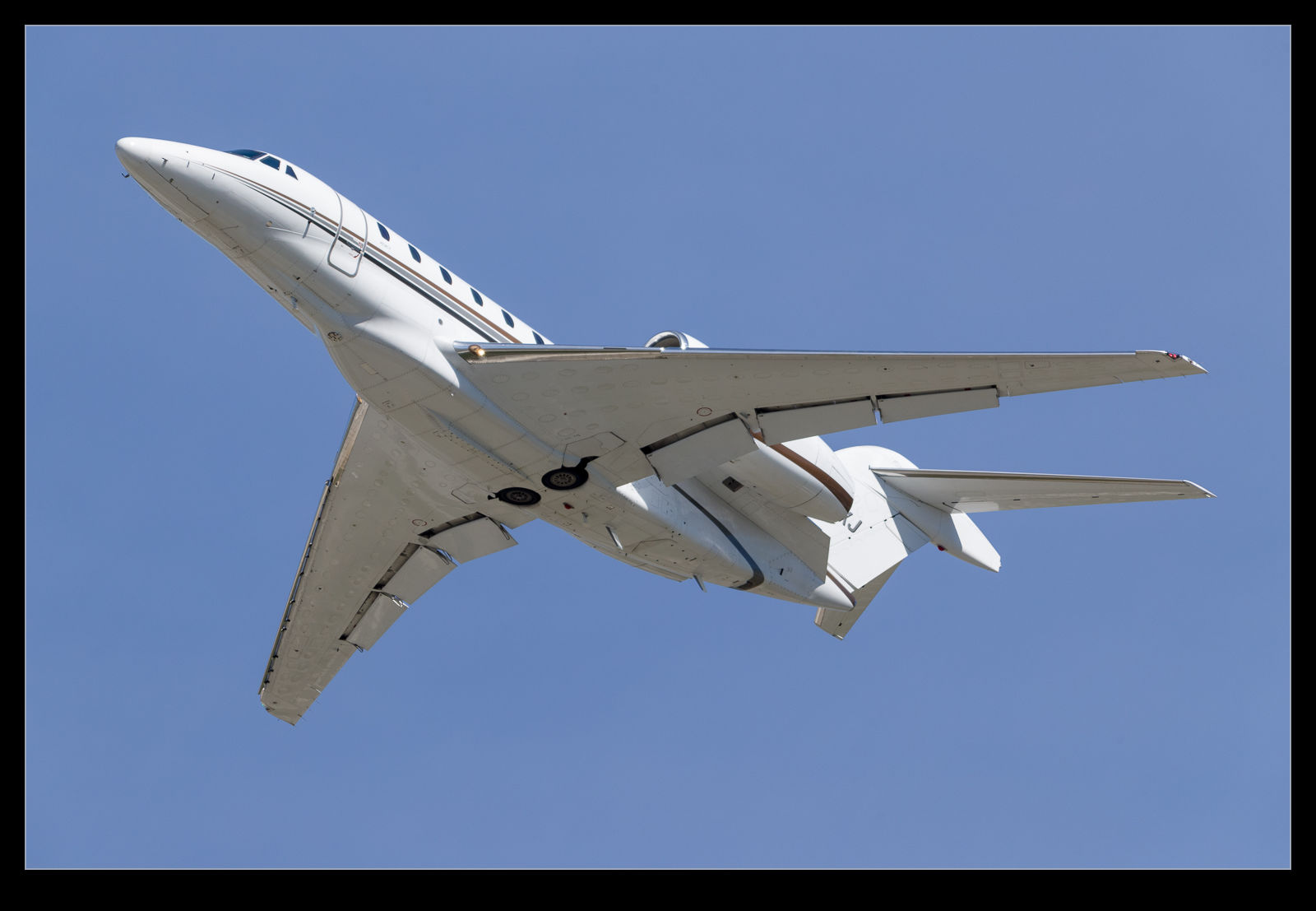 Today’s post is for my buddy Pete. Pete flies for a living and for fun. He loves to fly anything he can have a go with. There is one bizjets that he hasn’t got his hands on (yet) but which he really has a soft spot for. That is the Cessna Citation X. When it was introduced, the Citation X brought a far higher top speed than the competition. It did this by having two honking great engines strapped to a relatively small fuselage and a highly swept wing. It has been a popular seller.
Today’s post is for my buddy Pete. Pete flies for a living and for fun. He loves to fly anything he can have a go with. There is one bizjets that he hasn’t got his hands on (yet) but which he really has a soft spot for. That is the Cessna Citation X. When it was introduced, the Citation X brought a far higher top speed than the competition. It did this by having two honking great engines strapped to a relatively small fuselage and a highly swept wing. It has been a popular seller.
 It has been attractive to fractional programs as well as individuals so it is not unusual to see one show up at an airport that has regular bizjets traffic. Certain angles look good on the jet. Anything that emphasizes the size of the engines appeals to me but the sweep of the wings and the fin also give it a going fast while standing still feel. Here are some shots for you Pete.
It has been attractive to fractional programs as well as individuals so it is not unusual to see one show up at an airport that has regular bizjets traffic. Certain angles look good on the jet. Anything that emphasizes the size of the engines appeals to me but the sweep of the wings and the fin also give it a going fast while standing still feel. Here are some shots for you Pete.
FedEx Fleet Types
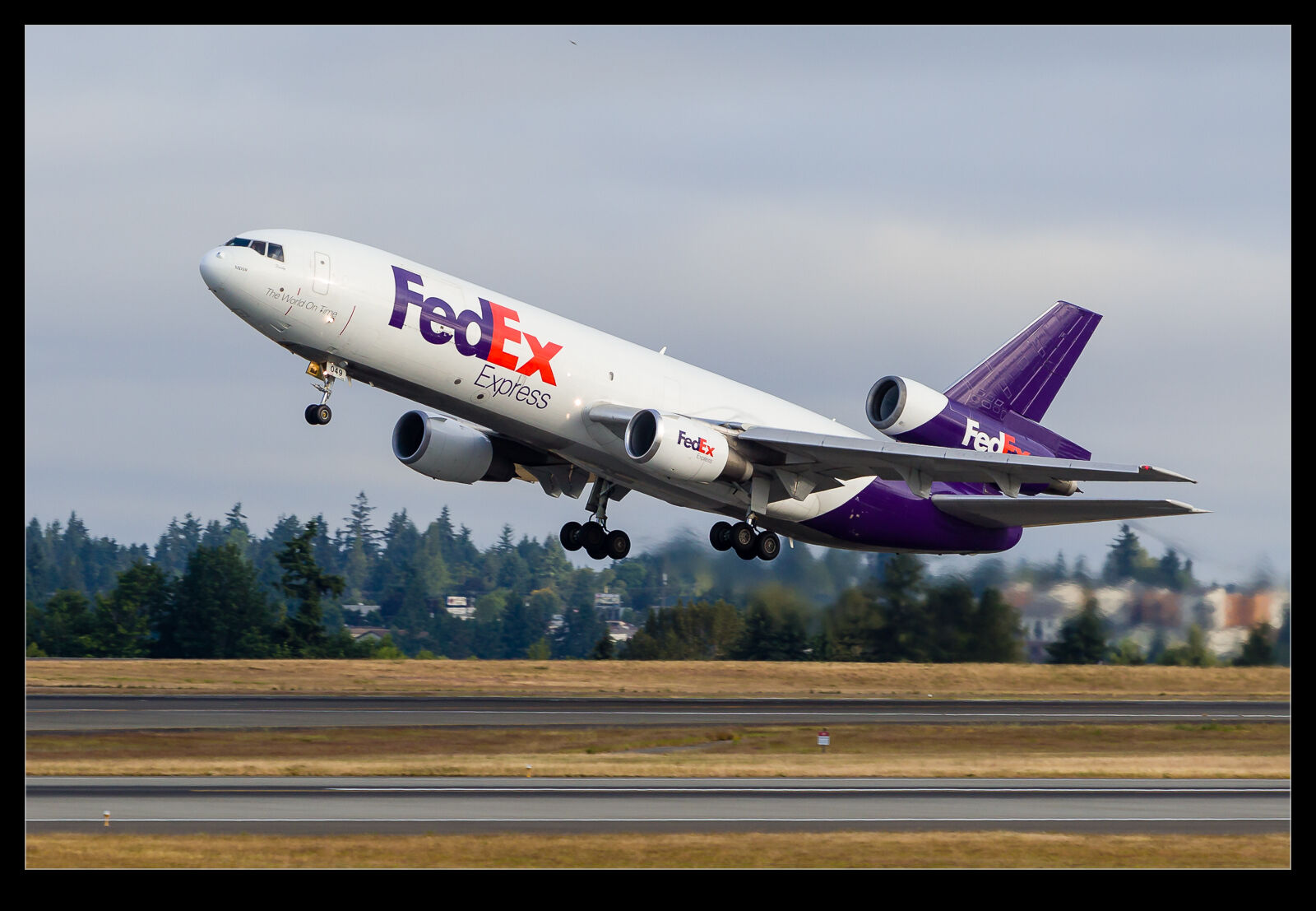 Flipping through various shoots looking for something else, I happened to come across a few shots of aircraft from the FedEx fleet. It occurred to me that I could drag together a post that was focused purely on the FedEx aircraft types. FedEx has an extensive fleet of aircraft these days. Their early days of using Falcon 20s to move their packages around are long gone. Now they have a variety of aircraft types of different sizes and range to meet all of their needs.
Flipping through various shoots looking for something else, I happened to come across a few shots of aircraft from the FedEx fleet. It occurred to me that I could drag together a post that was focused purely on the FedEx aircraft types. FedEx has an extensive fleet of aircraft these days. Their early days of using Falcon 20s to move their packages around are long gone. Now they have a variety of aircraft types of different sizes and range to meet all of their needs.
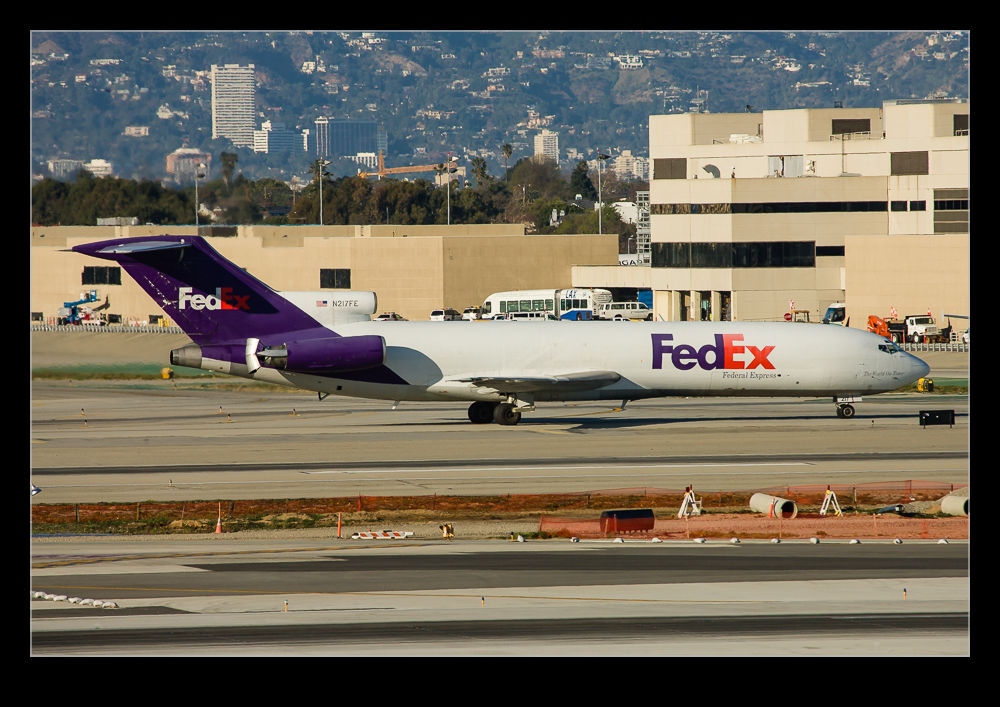 The fleet is constantly in a state of regeneration. The types that have long been a part of FedEx operations are now going or gone and being replaced with something more up to date. The 727 fleet has gone. The A300s and A310s are still in use but the number in the fleet is gradually going down. The interesting thing about the FedEx fleet is the way the economics are changing. For a long time, second hand jets that had been retired from airline service made a lot of sense. The operating model involves a lot of jets flying from their home base to Memphis in the middle of the night to deliver packages to the hub. Then, after a quick turnaround of all of the sorted packages, the planes fly back to base. Then they sit on the ground for most of the day.
The fleet is constantly in a state of regeneration. The types that have long been a part of FedEx operations are now going or gone and being replaced with something more up to date. The 727 fleet has gone. The A300s and A310s are still in use but the number in the fleet is gradually going down. The interesting thing about the FedEx fleet is the way the economics are changing. For a long time, second hand jets that had been retired from airline service made a lot of sense. The operating model involves a lot of jets flying from their home base to Memphis in the middle of the night to deliver packages to the hub. Then, after a quick turnaround of all of the sorted packages, the planes fly back to base. Then they sit on the ground for most of the day.
 This model means that utilization for the aircraft is low. Having a less efficient jet is not a problem when it only flies a few hours each day. If it is cheap to buy, you can use it efficiently. Having a bunch of inefficient 727s works very well. Similarly, the smaller aircraft that feed into hubs also can be operated relatively cheaply. A fleet of Cessna Caravans that sit on the ground or a bunch of ATR42s is effective.
This model means that utilization for the aircraft is low. Having a less efficient jet is not a problem when it only flies a few hours each day. If it is cheap to buy, you can use it efficiently. Having a bunch of inefficient 727s works very well. Similarly, the smaller aircraft that feed into hubs also can be operated relatively cheaply. A fleet of Cessna Caravans that sit on the ground or a bunch of ATR42s is effective.
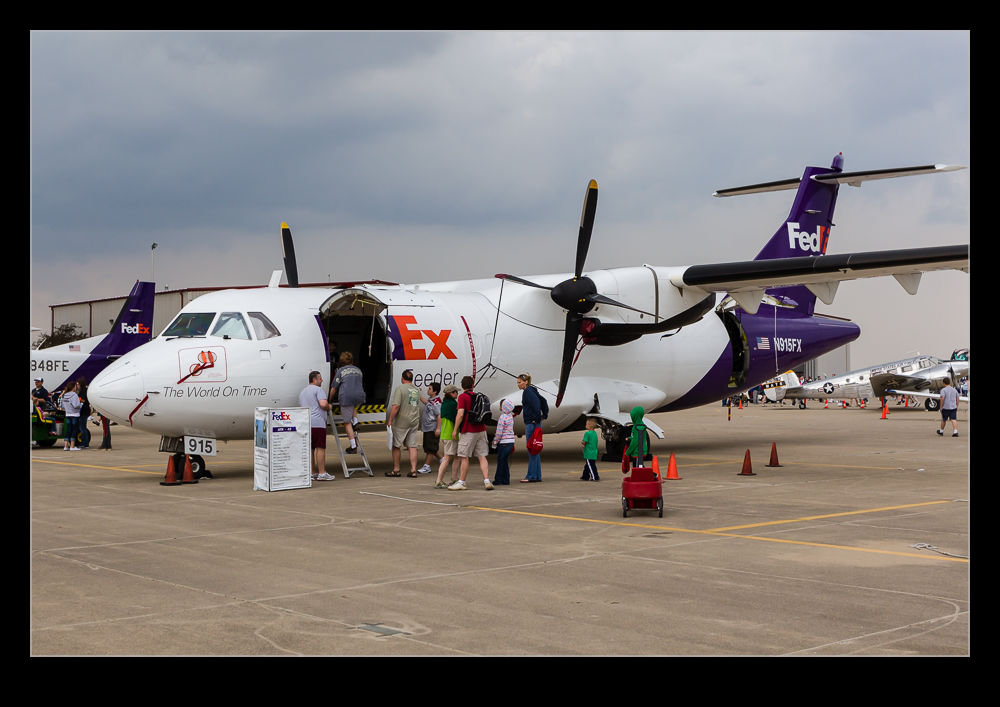 The 727s are gone now. They have been replaced with 757s which have all been retired by airline operators (a lot of them from British Airways).The big change is that new jets are being acquired. The operating economics for FedEx have changed. The DC-10s (which got upgraded to MD-10s) are gradually being replaced by new 767s. Meanwhile, the MD-11s which had previously been the kings of the long haul flights are now being relegated to domestic service while the 777F takes over the long haul missions. Direct from Memphis to China is now the norm for the 777F. You don’t see MD-11s crossing the Pacific as much any more. I think the Europe runs are limited too. The 777 can go direct with a decent payload and doesn’t need to stop for fuel in Anchorage.
The 727s are gone now. They have been replaced with 757s which have all been retired by airline operators (a lot of them from British Airways).The big change is that new jets are being acquired. The operating economics for FedEx have changed. The DC-10s (which got upgraded to MD-10s) are gradually being replaced by new 767s. Meanwhile, the MD-11s which had previously been the kings of the long haul flights are now being relegated to domestic service while the 777F takes over the long haul missions. Direct from Memphis to China is now the norm for the 777F. You don’t see MD-11s crossing the Pacific as much any more. I think the Europe runs are limited too. The 777 can go direct with a decent payload and doesn’t need to stop for fuel in Anchorage.
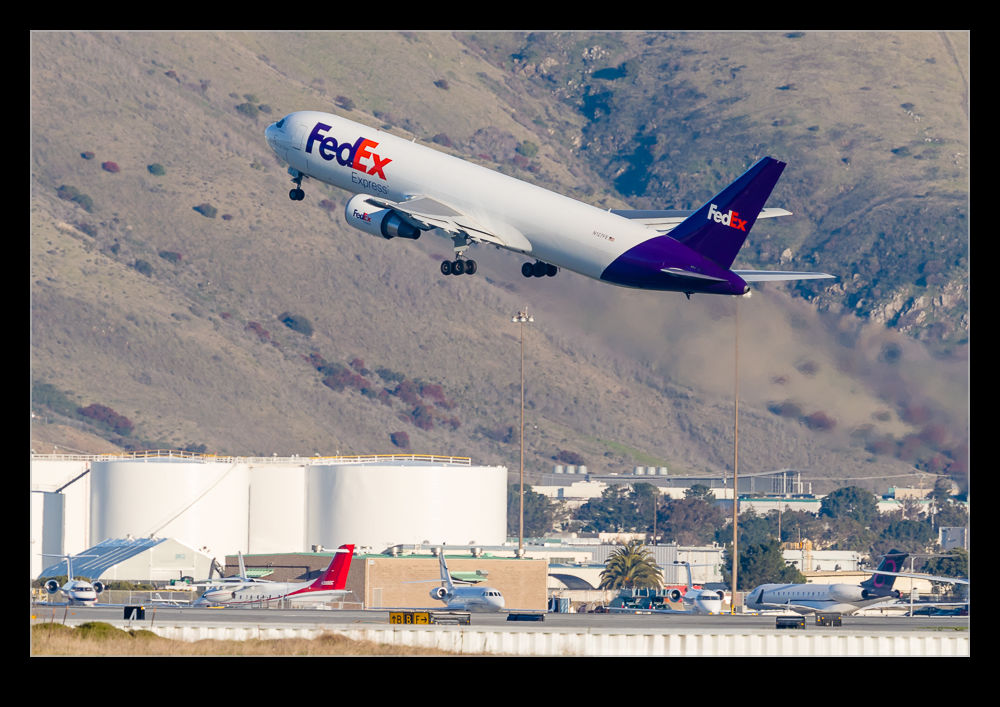 The MD-11 will survive for a while yet. Its less efficient operate will mean it can be pushed onto shorter segments with lower utilization. The high utilization missions will be the preserve of the newer jets. The older jets will be fine on the flights that only involve a couple of trips a day. For these their low capital costs will offset any operational cost penalty. The migration of the fleet will continue though. Soon it will be a fleet with a few less types and things will be a bit less interesting. There will still be a bunch of 727s scattered around airports that had them donated though so keep an eye out for them.
The MD-11 will survive for a while yet. Its less efficient operate will mean it can be pushed onto shorter segments with lower utilization. The high utilization missions will be the preserve of the newer jets. The older jets will be fine on the flights that only involve a couple of trips a day. For these their low capital costs will offset any operational cost penalty. The migration of the fleet will continue though. Soon it will be a fleet with a few less types and things will be a bit less interesting. There will still be a bunch of 727s scattered around airports that had them donated though so keep an eye out for them.
Customs Citation
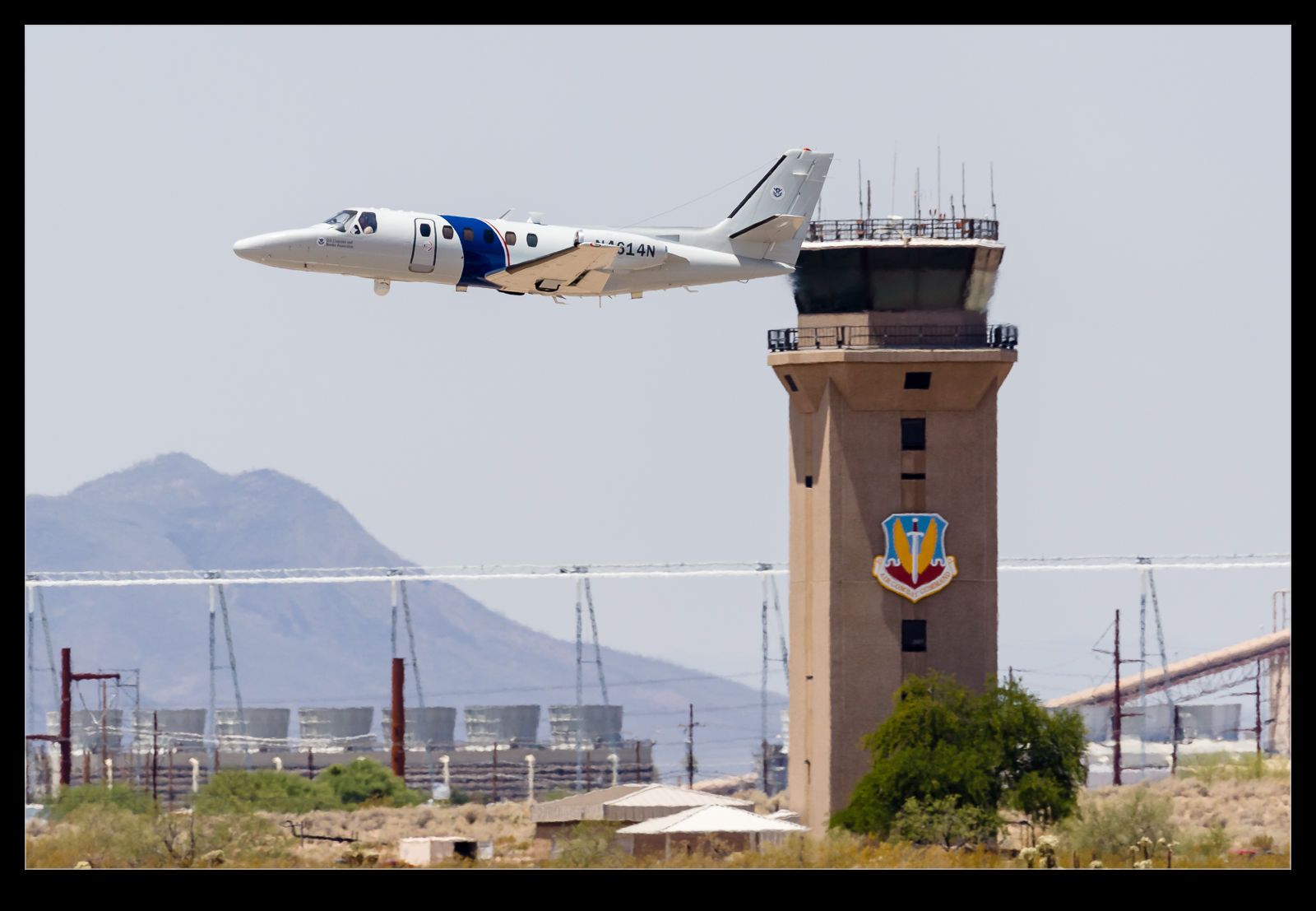 Cessna Citations are not the most exciting business jets. The original versions are particularly uninspiring with their simple design and unswept wing. Normally I might not even bother if I came across one. This example showed up at Davis Monthan while we were on the ramp and it obviously wasn’t a standard version. It belongs to the Customs people. I imagine it spends a lot of time looking at what is going on along the border. Flying out of Tucson would support that idea. I imagine the sensors on board are a lot more interesting than the plane itself.
Cessna Citations are not the most exciting business jets. The original versions are particularly uninspiring with their simple design and unswept wing. Normally I might not even bother if I came across one. This example showed up at Davis Monthan while we were on the ramp and it obviously wasn’t a standard version. It belongs to the Customs people. I imagine it spends a lot of time looking at what is going on along the border. Flying out of Tucson would support that idea. I imagine the sensors on board are a lot more interesting than the plane itself.
Grand Caravan Go Around – Thank-you
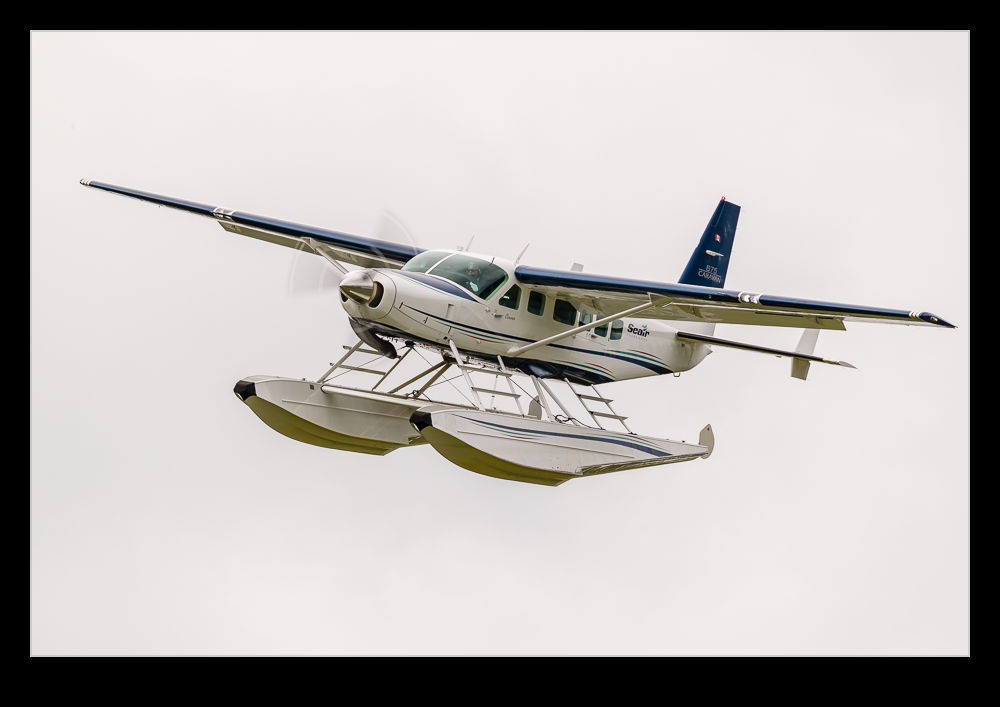 We spent a day in Stanley Park in Vancouver. This was not a day for photographing aircraft but there are so many operating in the area that it is hard to avoid. As we were walking along the shore, a Grand Caravan made an approach. I didn’t have the camera to hand so just watched it. Having made a dive at the final approach, it floated long (in the air, not on the water) and the pilot elected to go around. This gave me an opportunity to get the camera out.
We spent a day in Stanley Park in Vancouver. This was not a day for photographing aircraft but there are so many operating in the area that it is hard to avoid. As we were walking along the shore, a Grand Caravan made an approach. I didn’t have the camera to hand so just watched it. Having made a dive at the final approach, it floated long (in the air, not on the water) and the pilot elected to go around. This gave me an opportunity to get the camera out.
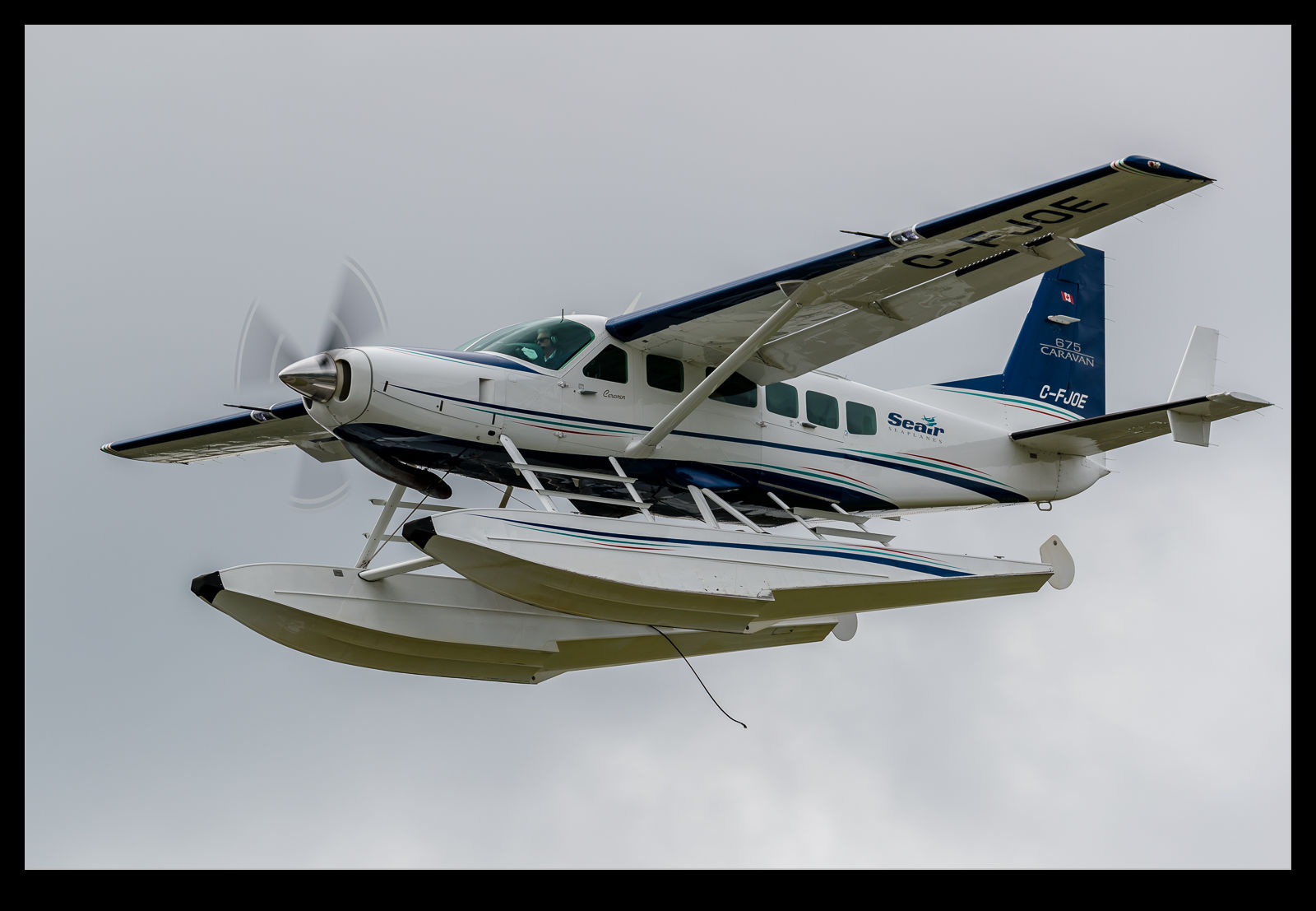 Meanwhile, I could hear it coming around. It seemed rather loud for the approach path it had taken previously. Indeed, this time they took a path right across the bottom of the park. I got out from under a tree just in time to get some shots of it turning on to final. A far better angle than its first approach. Maybe the pilot deliberately went around because he knew what I wanted?
Meanwhile, I could hear it coming around. It seemed rather loud for the approach path it had taken previously. Indeed, this time they took a path right across the bottom of the park. I got out from under a tree just in time to get some shots of it turning on to final. A far better angle than its first approach. Maybe the pilot deliberately went around because he knew what I wanted?
Grand Caravan is Not the Smoothest!
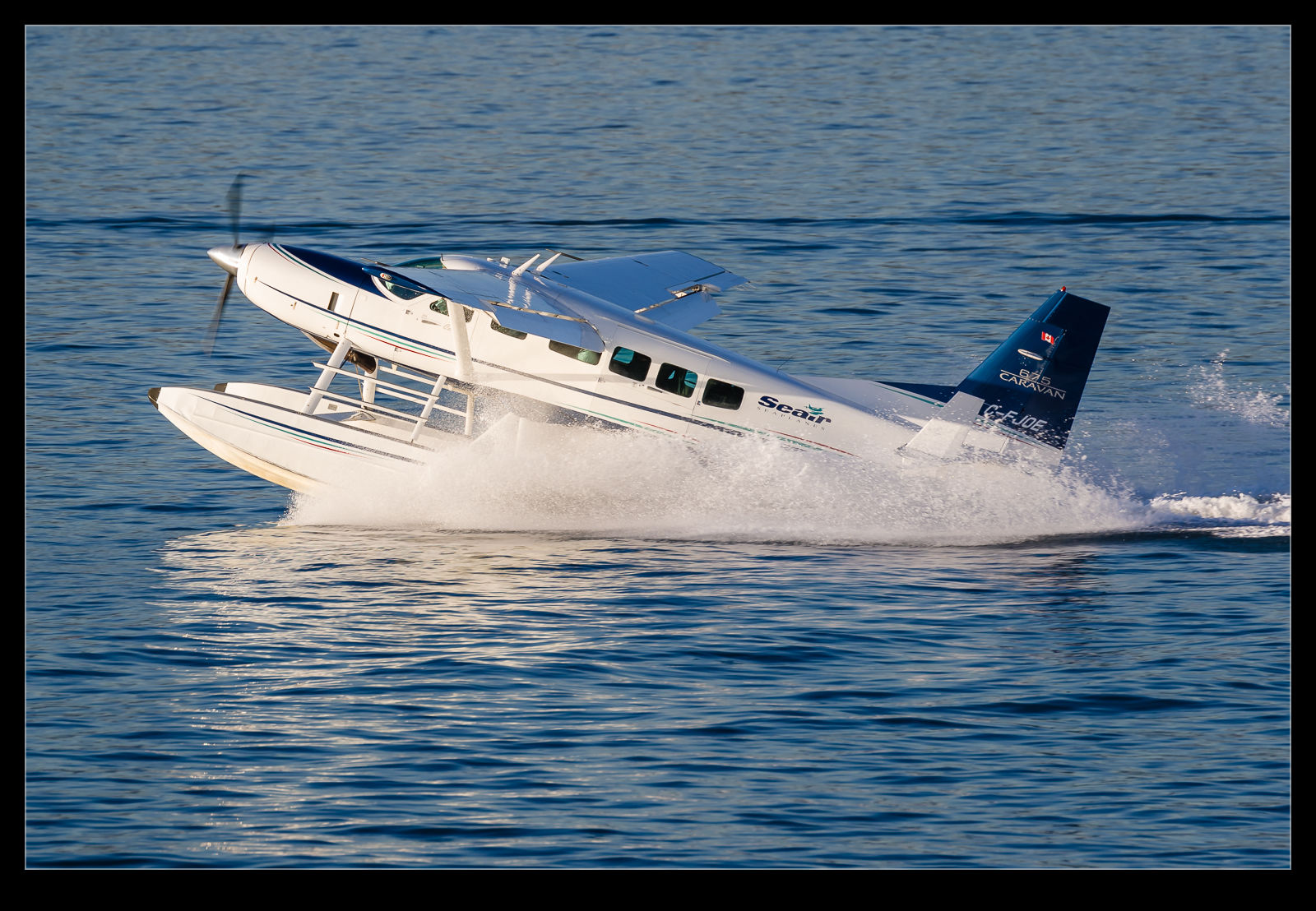 It might seem a bit absurd but, when watching all of the floatplane activity down in the harbor in Vancouver, you can get a bit used to the Otters and Beavers and hope for something a little different. One operator was using a Cessna Grand Caravan on floats and this got my interest. I saw it coming in on the approach and watched it all through the touchdown and slowing down to taxi speed.
It might seem a bit absurd but, when watching all of the floatplane activity down in the harbor in Vancouver, you can get a bit used to the Otters and Beavers and hope for something a little different. One operator was using a Cessna Grand Caravan on floats and this got my interest. I saw it coming in on the approach and watched it all through the touchdown and slowing down to taxi speed.
 The transition off the step and onto the floats did not seem to be a very smooth process. As the speed decayed, the aircraft pitched up and then oscillated between level and very nose high. The tail seemed to get very close to the water and there was plenty of spray. I have no idea whether this is the normal transition or whether this one got a bit out of sorts due to the conditions but it did no look like it would have been very comfortable inside. All was well, though. They flew out again a little while later with no issues.
The transition off the step and onto the floats did not seem to be a very smooth process. As the speed decayed, the aircraft pitched up and then oscillated between level and very nose high. The tail seemed to get very close to the water and there was plenty of spray. I have no idea whether this is the normal transition or whether this one got a bit out of sorts due to the conditions but it did no look like it would have been very comfortable inside. All was well, though. They flew out again a little while later with no issues.
Southwest Evasive Maneuvers
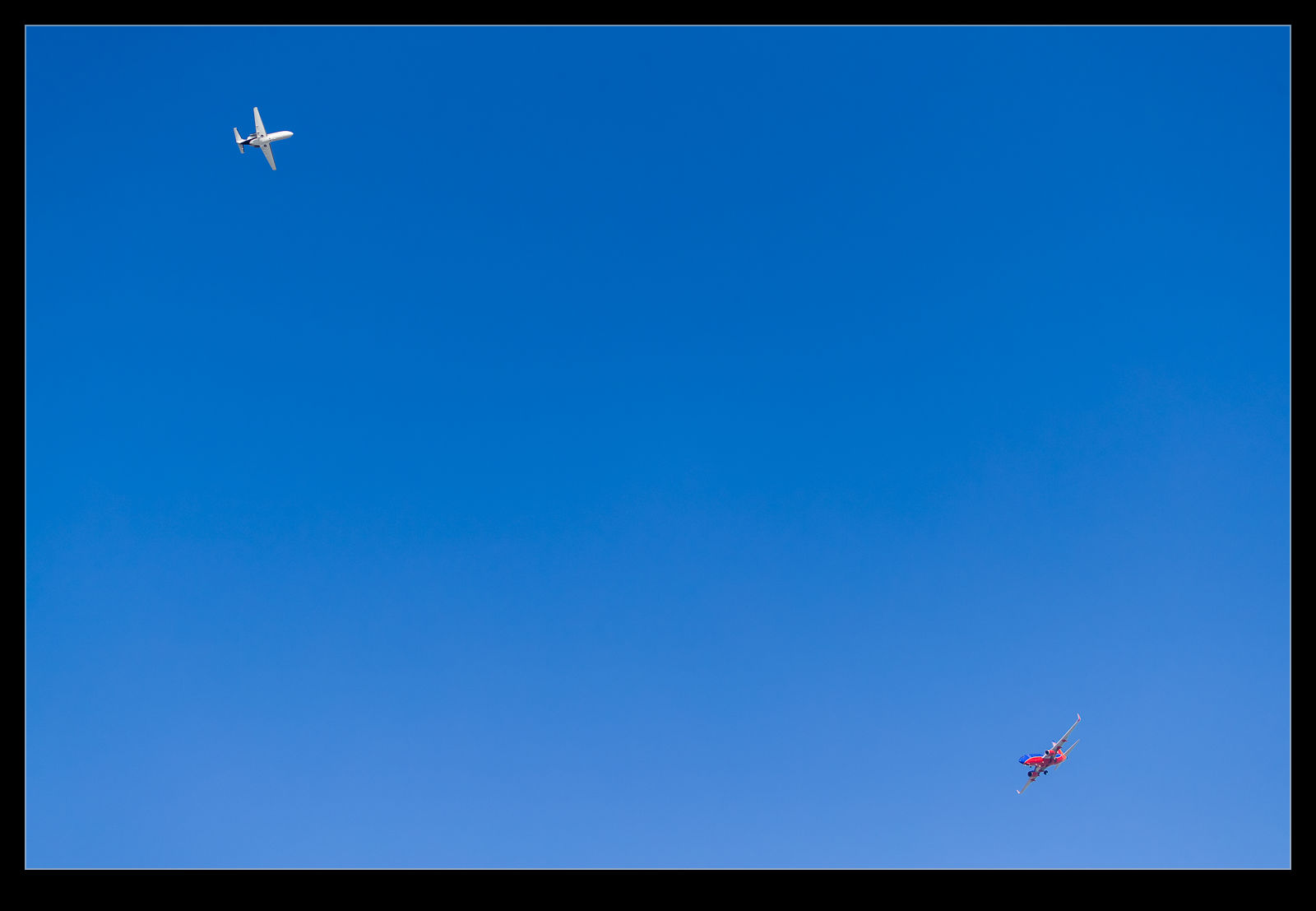 This was not an aircraft photography trip. I was taking a walk along the shore at Hayward Regional Park. It is a place with lots of wildlife and views across the bay. It is also near the approach to Oakland so I did have the chance to take aircraft pictures if I wanted. That wasn’t the goal though. It didn’t stay that way though. The approach to Oakland involves flying right by Hayward Airport. Hayward has a lot of general aviation traffic. The spam cans are intermixed with some corporate jets.
This was not an aircraft photography trip. I was taking a walk along the shore at Hayward Regional Park. It is a place with lots of wildlife and views across the bay. It is also near the approach to Oakland so I did have the chance to take aircraft pictures if I wanted. That wasn’t the goal though. It didn’t stay that way though. The approach to Oakland involves flying right by Hayward Airport. Hayward has a lot of general aviation traffic. The spam cans are intermixed with some corporate jets.
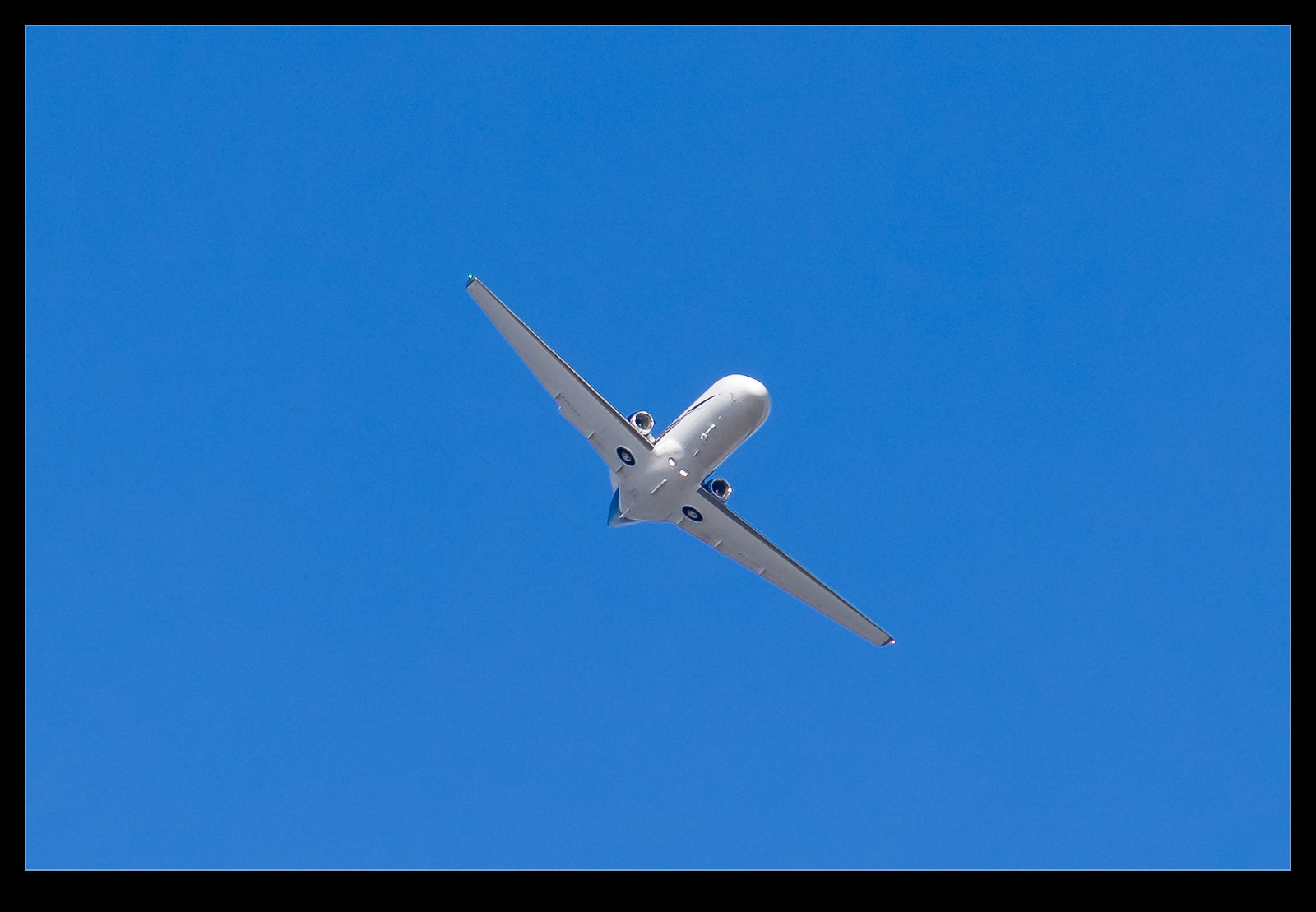 What caught my eye was the incoming Southwest 737 and a departing Cessna CJ M2. The CJ took off and entered a climbing left turn. This put it into the path of the Southwest 737. I don’t know who was at fault in this. Was the Southwest jet too close, did the CJ pilot break his cleared departure profile or should Hayward tower never let him go? I don’t know. Whatever the reason, they were heading towards each other.
What caught my eye was the incoming Southwest 737 and a departing Cessna CJ M2. The CJ took off and entered a climbing left turn. This put it into the path of the Southwest 737. I don’t know who was at fault in this. Was the Southwest jet too close, did the CJ pilot break his cleared departure profile or should Hayward tower never let him go? I don’t know. Whatever the reason, they were heading towards each other.
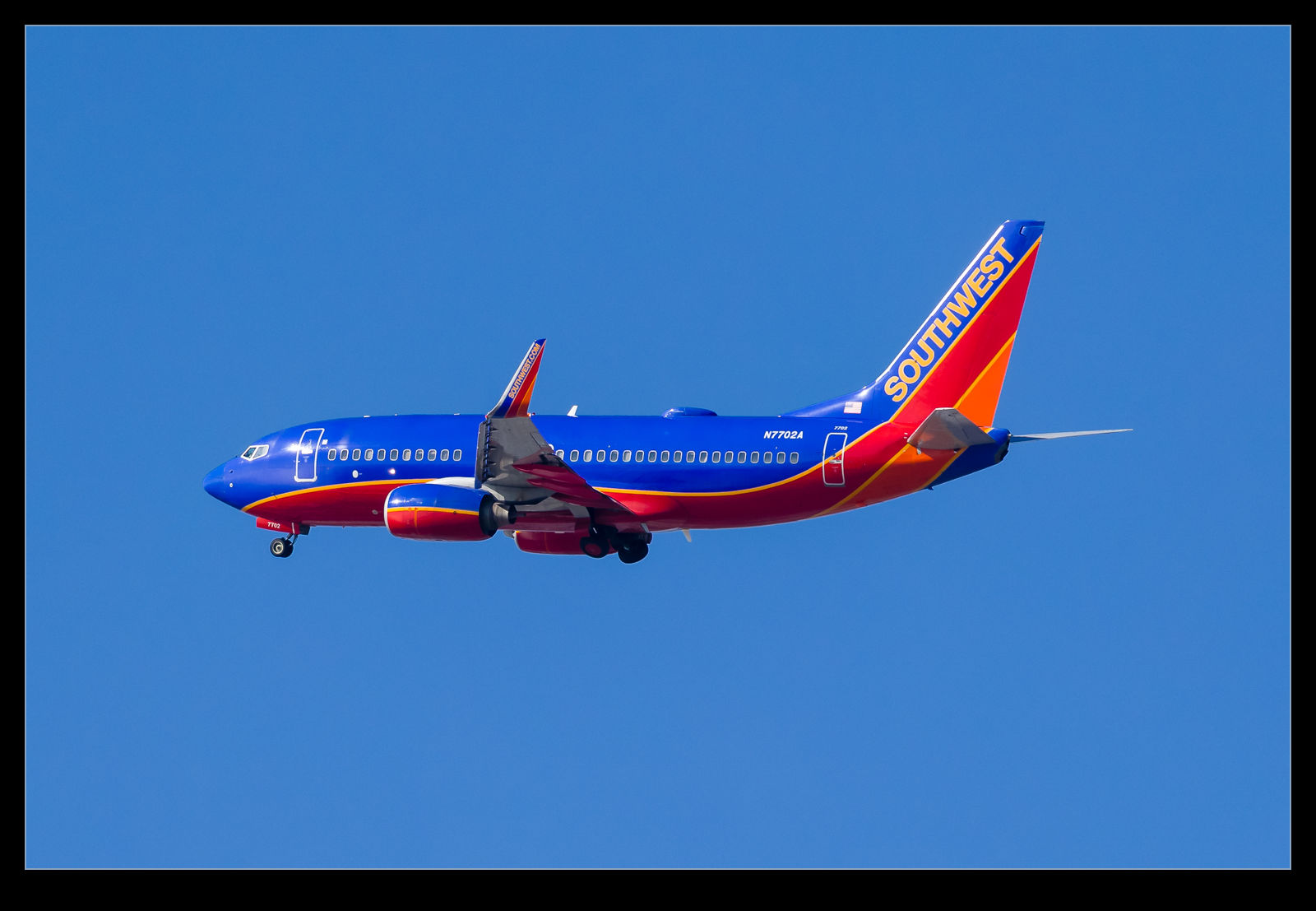 I also don’t know whether the Southwest crew saw the CJ first or if the TCAS gave them a resolution notice. Whatever happened, they took some pretty dramatic avoiding action. I imagine it felt pretty interesting from inside the cabin. They gained good separation and everything was fine. At first I thought they were going to try and get reestablished on the approach but cooler heads prevailed and they cleaned up the jet and went around. After some time to let the heart rate fall, they appeared back on the approach for a more conventional approach. All ended well. I wonder how the conversations went after landing.
I also don’t know whether the Southwest crew saw the CJ first or if the TCAS gave them a resolution notice. Whatever happened, they took some pretty dramatic avoiding action. I imagine it felt pretty interesting from inside the cabin. They gained good separation and everything was fine. At first I thought they were going to try and get reestablished on the approach but cooler heads prevailed and they cleaned up the jet and went around. After some time to let the heart rate fall, they appeared back on the approach for a more conventional approach. All ended well. I wonder how the conversations went after landing.
